Difference between revisions of "User:Heritagefutures"
(→Chronology of Models) |
(→History) |
||
| Line 244: | Line 244: | ||
| − | |||
| − | |||
| − | |||
| − | |||
| − | |||
| − | |||
| − | |||
| − | |||
| − | |||
| − | |||
| − | |||
| − | |||
| − | |||
| − | |||
| − | |||
| − | |||
| − | |||
| − | |||
| − | |||
| − | |||
| − | |||
| − | |||
| − | |||
| − | |||
| − | |||
| − | |||
| − | |||
| − | |||
==Dichotomous Key to aid identification of models== | ==Dichotomous Key to aid identification of models== | ||
| Line 443: | Line 415: | ||
<!-- INTERACTIVE DICHOTOMOUS KEY ENDS HERE -- INTERACTIVE DICHOTOMOUS KEY ENDS HERE -- INTERACTIVE DICHOTOMOUS KEY ENDS HERE --> | <!-- INTERACTIVE DICHOTOMOUS KEY ENDS HERE -- INTERACTIVE DICHOTOMOUS KEY ENDS HERE -- INTERACTIVE DICHOTOMOUS KEY ENDS HERE --> | ||
<!-- XXXXXXXXXXXXXXXXXXXXXXXXXXXXXXXXXXXXXXXXXXXXXXXXXXXXXXXXXXXXXXXXXXXXXXXXXXXXXXXXXXXXXXXXXXXXXXXXXXXXXXXXXXXXXXXXXXX --> | <!-- XXXXXXXXXXXXXXXXXXXXXXXXXXXXXXXXXXXXXXXXXXXXXXXXXXXXXXXXXXXXXXXXXXXXXXXXXXXXXXXXXXXXXXXXXXXXXXXXXXXXXXXXXXXXXXXXXXX --> | ||
| + | |||
| + | |||
| + | |||
| + | |||
| + | |||
| + | <center> | ||
| + | {|class=plainlinks align="center" style="text-align: center;" | ||
| + | ||[http://www.flickr.com/photos/heritagefutures/5243452892/in/pool-camerapedia/ http://farm6.static.flickr.com/5205/5243452892_1f88cf2af0_m.jpg]<br>[[Mamiya Six I]] | ||
| + | |bgcolor="#EEEEEE" style="vertical-align: bottom;"|<br>[[Mamiya Six Ia]] | ||
| + | ||[http://www.flickr.com/photos/heritagefutures/5143934611/in/pool-camerapedia/ http://farm2.static.flickr.com/1192/5143934611_684fbccfb5_m.jpg]<br>[[Mamiya Six II]] | ||
| + | ||[http://www.flickr.com/photos/heritagefutures/5256561097/in/pool-camerapedia/ http://farm6.static.flickr.com/5006/5256561097_791e915a88_m.jpg]<br>[[Mamiya Six IIa]] | ||
| + | |- | ||
| + | ||[http://www.flickr.com/photos/heritagefutures/5260055103/in/pool-camerapedia/ http://farm6.static.flickr.com/5248/5260055103_ec7f7d42aa_m.jpg]<br>[[Mamiya Six III]] | ||
| + | ||[http://www.flickr.com/photos/heritagefutures/5260798892/in/pool-camerapedia/ http://farm6.static.flickr.com/5205/5260798892_f47fa13428_m.jpg]<br>[[Mamiya Six IV]] | ||
| + | |bgcolor="#EEEEEE" style="vertical-align: bottom;"|<br>[[Mamiya Six V]] | ||
| + | |bgcolor="#EEEEEE" style="vertical-align: bottom;"|<br>[[Mamiya Six IVb]] | ||
| + | |- | ||
| + | |bgcolor="#EEEEEE" style="vertical-align: bottom;"|<br>[[Mamiya Six IVs]] | ||
| + | ||[http://www.flickr.com/photos/heritagefutures/5260128111/in/pool-camerapedia/ http://farm6.static.flickr.com/5005/5260128111_aba0948305_m.jpg]<br>[[Mamiya Six K]] | ||
| + | |bgcolor="#EEEEEE" style="vertical-align: bottom;"|<br>[[Mamiya Six K2]] | ||
| + | |bgcolor="#EEEEEE" style="vertical-align: bottom;"|<br>[[Mamiya Six P]] | ||
| + | |- | ||
| + | || | ||
| + | |bgcolor="#EEEEEE" style="vertical-align: bottom;"|<br>[[Mamiya Six Automat]] | ||
| + | |bgcolor="#EEEEEE" style="vertical-align: bottom;"| <br> <br> <br> <br> <br> <br> <br> <br> <br>[[Mamiya Six Automat 2]] | ||
| + | |||
| + | |- | ||
| + | | colspan=4 | ''The various models of the Mamiya Six <br><small>Images by Dirk HR Spennemann. {{with permission}}</small>'' | ||
| + | |} | ||
| + | </center> | ||
=Patent Applications= | =Patent Applications= | ||
Revision as of 21:37, 6 January 2011
Contents
- 1 Collection Interests (eclectic)
- 2 Websites
- 3 Resources
- 4 MY SANDBOX
- 5 PAGE ONE -- MAIN ENTRY FOR MAMIYA-SIX
- 6 History
- 7 Patent Applications
- 8 Notes
- 9 PAGE SIX -- Mamiya Six V
- 10 Notes
- 11 PAGE SEVEN -- Mamiya Six K
- 12 Notes
- 13 PAGE EIGHT -- Mamiya Six IVb
- 14 Notes
- 15 PAGE NINE -- Mamiya Six Automat
- 16 Patent Application
- 17 Notes
- 18 PAGE TEN -- Mamiya Six K2
- 19 Notes
- 20 PAGE ELEVEN -- Mamiya Six IVs
- 21 Notes
- 22 PAGE TWELVE -- Mamiya Six P
- 23 Notes
- 24 PAGE THIRTEEN -- Mamiya Six Automat 2
- 25 Notes
Collection Interests (eclectic)
- Simmon-Omega/Koni-Omega family of cameras
- Japanese aerial and other military cameras
- Foth & Co cameras and binoculars
- → Foth Derby
- → Foth-Flex
- Konica model I cameras (variants)
- Cameras with Gitzo Shutters and Gitzo gear (older stuff preferred)
- Konishiroku and Rokuoh-sha (not systematic)
- Mamiya Six cameras (variants)
- → Mamiya Six I
- → Mamiya Six II
- → Mamiya Six III
- → Mamiya Six IV
- → Mamiya Six Design Variations
- → Mamiya Six Accessories
Websites
WIP
Resources
| START : How many viewfinder windows are on the front? |
TWO Windows
|
THREE Windows
|
six-pane documentation

|

|

|

|

|

|
| Mamiya Six Model XXXXXX. Images by Dirk HR Spennemann. (Image rights) | ||
| DIRECTIONS WHAT"S TO BE SEEN | |
|
ADDITIONAL TEXT OR ILLUSTRATIONS GO HERE | |
right float image

|
| CAPTION CAPTION CAPTION Image by Dirk HR Spennemann. (Image rights) (Image rights) |
MY SANDBOX
Mamiya 50th Anniversary FN [1]
PAGE ONE -- MAIN ENTRY FOR MAMIYA-SIX
This article is about the spring-folder camera made by Mamiya in the 1940s and 50s. For the 1990s camera, see Mamiya 6.
The Mamiya Six is a series of 6×6 folders with a coupled rangefinder, made by Mamiya from 1940 to the 1950s. All of them are focused by moving the film plane, rather than the more common front-cell focussing of other folders of the time.
History
The brain behind the development of the Mamiya Six was the inventor Seiichi Mamiya. His camera design departed from the common method of front cell focussing. In order to be able to control the camera when looking through the rangefinder while maintaining a steady hold,[2] he designed a method that allowed the film plane to move in relation to the lens. He filed his invention on 1 July 1939 in Japan[3], on ¶¶ 1940 in the United Kingdom[4] and on 5 June 1940 in the U.S.A. The U.S. Patent (nº 2,305,301) was granted on 15 December 1942, but, because of the state of war between the USA and Japan, was vested in the Alien Property Custodian.[5]
Evolution

|
| Prototpye of the Mamiya Six Image in Asahi Camera (アサヒカメラ) July 1951, p. 88 Scanned by rebollo_fr. (Image rights) |
The first model (Mamiya Six I) was advertised in September 1940 and first went on sale in December 1940. Until the end of the World War II, the Mamiya Six was significantly modified at least three times: first in early 1941 (model Ia) with two additional improved models introduced in the next two years. Erratically, model III was released in 1942[6] before model II appeared in 1943. All pre-war and war-time models have a twin set of range finder windows as well as a small, seperate Brillant-type waist-level viewfinder, resulting in three windows at the front. All units have a single red film frame counter window counter on the back with a horizontal slider opening to the left. The Mamiya Six III added an exposure counter with double exposure prevention. The pre-war and war-time models were all 6x6 format cameras.
Production of the Mamiya Six was restarted after World War II. The first cameras to be sold were Mamiya Six III. It is not clear to what extent these units were assembled from existing spare parts, or whether all are totally new construction. The official Mamiya history states that ¶¶¶ These post-War Mamiya Six III were fitted with which was introduced in Takatiho Tokio Zuiko f/3.5 75mm lenses, which debuted in 1946.[7] The first new model to appear was the Mamiya Six IV, introduced in 1947, which dispensed with the waist-level finder. It remained the sole model until 1953. The Mamiya Six V added the dual 6×6 and 4.5×6 format capability, with an exposure counter functioning with both formats. The Mamiya Six K was a simpler model, with film advance via red windows.
In 1955, the Mamiya Six IVb introduced a squarer body design, easily recognized by the square rangefinder window. Its features were similar to the model IV. The Mamiya Six K2 was similar to the model K with the new body. The body design was slightly modified again for the Mamiya Six IVs and simpler Mamiya Six P.
From 1955, the Mamiya Six Automat and the later Automat 2 added a coupling between the shutter cocking and the film advance.
Chronology of Models
Given the quite erratic nature of model numbering that occurred over the years, the chronology of the thirteen major Mamiya Six models is set out in Table 1. The characteristcs of the individual models, as well as the variants within these models, are described further below. If in doubt about some of the features mentioned in the type descriptions, please refer to the visual documentation of the critical elements which provides a dichotomous key as well as a series of illustrations showing the model-specific details.
Table 1 Chronology of Mamiya Six Cameras
| Release Date | Model/Variant | |
| pre-War Production | 1940, September | Mamiya Six I |
| 1941, January |
Mamiya Six Ia | |
| War Production | 1942, January | Mamiya Six III |
| 1943 | Mamiya Six II | |
| 1943? | Mamiya Six IIa | |
| 1945 |
Production Ceased | |
| post-War Production | 1946, November | Mamiya Six III |
| 1947 | Mamiya Six IV | |
| 1953, November | Mamiya Six V | |
| 1954, August | Mamiya Six K | |
| 1955, May | Mamiya Six IVb | |
| 1955, December | Mamiya Six Automat | |
| 1956, March | Mamiya Six K2 | |
| 1957, October | Mamiya Six IVs | |
| 1957, December | Mamiya Six P | |
| 1958 | Mamiya Six Automat 2 |
Dichotomous Key to aid identification of models
The Mamiya Six comes in a bewildering range of variants. The interactive, dichotomous key provided below provides an avenue at identifying the types of Mamiya Six. Once you have identified your model, click on the model name to be taken to a full description. If you are unclear about any of the criteria, either click on the criterion name or jump to this page for visual identification guides.
| Use this interactive key to help identify your Mamiya Six model | ||||||||||||||||||||||||||||||||||||||||||||||||||||||||||||||
| How many viewfinder windows are on the front? | ||||||||||||||||||||||||||||||||||||||||||||||||||||||||||||||
| ||||||||||||||||||||||||||||||||||||||||||||||||||||||||||||||
| ||||||||||||||||||||||||||||||||||||||||||||||||||||||||||||||
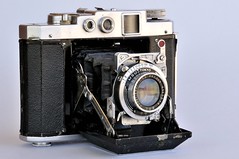 Mamiya Six I |
Mamiya Six Ia |
 Mamiya Six II |
 Mamiya Six IIa |
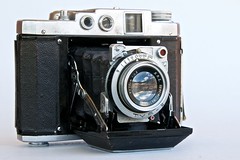 Mamiya Six III |
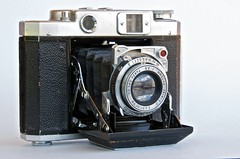 Mamiya Six IV |
Mamiya Six V |
Mamiya Six IVb |
Mamiya Six IVs |
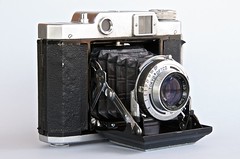 Mamiya Six K |
Mamiya Six K2 |
Mamiya Six P |
Mamiya Six Automat |
Mamiya Six Automat 2 | ||
| The various models of the Mamiya Six Images by Dirk HR Spennemann. (Image rights) | |||
Patent Applications
 | 
|
 | 
|
| Illustrations accompanying Seiichi Mamiya's Japanese Utility Model (Patent) application for the Mamiya Six focussing system [8] Images by rebollo_fr. (Image rights) | |
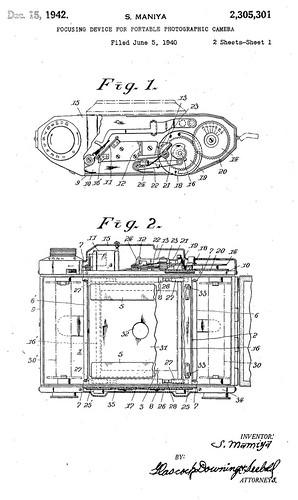 |
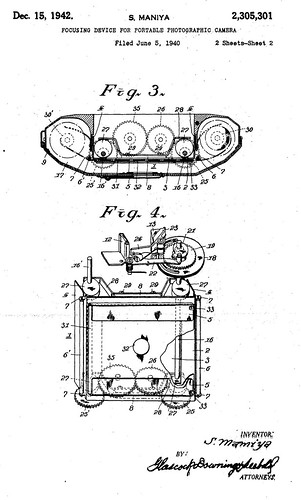 |
| Illustrations accompanying Seiichi Mamiya's U.S. Patent application[9] for the Mamiya Six focussing system Images by Dirk HR Spennemann. (Image rights) | |
Notes
- ↑ Mamiya. A History of Innovation. Mamiya 50th Anniversary. Produced by the Mamiya-History of Innovation Editorial Committee. Bunkyo-ku, Tokyo: Mamiya Camera Co. Ltd. p.
- ↑ Seiichi Mamiya had field an earlier application with the British Patent Office (for an improvement in single lens reflex cameras) again emphasising the need to be bale to maintain control when focussing. While that application was successful, the patent was not granted as Mamiya failed to pay the sealing fee: "Improvements In Or Relating To Photographic Cameras. Patent GB326688. Filed 17 April 1929; Published 20 March 1930.[| GB-Patent-326688/]
- ↑ Japanese utility model publication (実用新案出現広告) no.S15-14673. Applied for (出現) on Jul. 1, 1939 and published (公告) on Oct. 5, 1940.
- ↑ Improvements In And Relating To Focusing Devices For Portable Photographic Cameras. Patent GB542016. Filed ¶¶. Published 22 December 1941.
- ↑ Focussing Device for Portable Photographic Cameras. Patent application by Seiichi Mamiya, Ohita, Takata-Gun, Japan. Filed 5 June 1940, granted 15 December 1942. U.S. Patent nº 2,305,301.
- ↑ According to the official Mamiya history website | History of Mamiya Six (Mamiya history website)
- ↑ See the lens chronology on the Zuiko page.
- ↑ Japanese utility model publication (実用新案出現広告) no.S15-14673. Applied for (出現) on Jul. 1, 1939 and published (公告) on Oct. 5, 1940.
- ↑ Focussing Device for Portable Photographic Cameras. Patent application by Seiichi Mamiya, Ohita, Takata-Gun, Japan. Filed 5 June 1940, granted 15 December 1942. U.S. Patent nº 2,305,301.
PAGE SIX -- Mamiya Six V
November 1953 Mamiya 6-V Dual format (6x4.5cm and 6x6cm) with automatic film winding adjustment. Maximum shutter speed improved to 1/500 sec.
Technical details
- TEXT TEXT TEXT
Dimensions
- TEXT TEXT TEXT
Lens and shutter combinations
- Kowa Optical Works Prominar f/3.5 75mm
- Olympus D Zuiko F.C. f/3.5 75mm
- Olympus Zuiko F.C. f/3.5 75mm
Notes
PAGE SEVEN -- Mamiya Six K
The Mamiya Six-K was introduced in August 1954 as a popular, lower priced version of Mamiya 6-V. It lacks not only the automatic film winding stop but also lacks the red double exposure warning pane in the viewfinder, which had been a characteristic of the earlier models.
Technical details
The front range finder windows of the Mamiya Six-K resemble those of the Mamiya IV (a round window at the left and a rectangular window on the right, surrounded by a small screwed-on frame). the margins of the frame of the Mamiya Six K are narrower than those of the Mamiya IV.[1] The name tag of the camera is ¶¶¶ The catch for the film door opens upwards, rather than downwards as was the case with the earlier Mamiya Six models.
The serial numbering was restarted for the Mamiya Six K and followed through with the Mamiya Six K2. At the same time, the serial number block 2xx,xxx was not used for the Mamiya Six series.
Dimensions
- TEXT TEXT TEXT
Lens and shutter combinations
- Setagaya Kōki Sekor T f/3.5 75mm (silver face)
- Tokyo Opt. Co Toko f/3.5 75mm (black face)
- in TOKYO OPT CO-badged RECTUS (B, T, 1-200th) shutter[4]
Notes
- ↑ The design has been taken from the Mamiya IV as the Mamiya V has a long a long plate supporting BOTH the circular and the rectangular window.
- ↑ [[ http://neco.aki.gs/neco99/neco30/00/mamiya/031223.html |Neco's Mamiya Site]]
- ↑ [[ http://neco.aki.gs/neco99/neco30/00/mamiya/031224.html |Neco's Mamiya Site]]
- ↑ sn#9616—Photographica Collection Dirk HR Spennemann.—The Lens and shutter combination on the unit is somewhat unusual. The Combination of Toko f/3.5 75mm with Tōkyō Kōgaku RECTUS shutter can be found on the [PrimoFlex IB]. Until more units with this shutter combination come to light, we may have to assume that this is a post-market custom modification.
PAGE EIGHT -- Mamiya Six IVb
May 1955 Mamiya 6-iV B Camera body size and weight were reduced to increase compactness.
??? new rangefinder in this model??
The design by Seiichi Mamiya was applied in Japan on 23 June 1954 and in the USA on 20 June 1955 (granted 24 June 1958).[1]
Technical details
- TEXT TEXT TEXT
Dimensions
- TEXT TEXT TEXT
Lens and shutter combinations
Notes
- ↑ Camera rangefinder. Patent application by Seiichi Mamiya, Bunkyo-Ku, Tokyo-to, Japan. Filed 12 May 1955, granted 8 October 1957. U.S. Patent nº 2,808,770.
- ↑ [[ http://www.flickr.com/photos/elmoalves/4315236143%7CFlickr image]]
- ↑ [[ http://www.flickr.com/photos/blackfacesheep/5092156263/%7CFlickr image]]
- ↑ [[ http://page2.auctions.yahoo.co.jp/jp/auction/b117574345%7CYahoo Auction, seen December 2010]]
PAGE NINE -- Mamiya Six Automat
The Mamiya Six Automat was released in December 1955. It was the first Japanese camera which automatically cocked the shutter when advancing the film. The design for the automatic shutter cocking device was applied for by Seiichi Mamiya in Japan on 23 June 1954 and in the USA on 20 June 1955 (granted 24 June 1958).[1] On release, the camera was offered for ¥29.500.[2]
Technical details
- TEXT TEXT TEXT
Dimensions
- 140 x 104 x 55 mm (closed); ¶¶¶ (open); weight 850g
Lens and shutter combinations
Patent Application
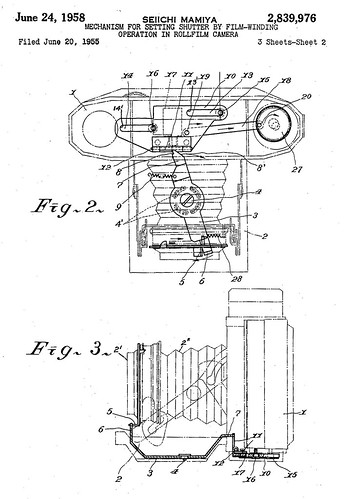 |
 |
| Illustrations accompanying Seiichi Mamiya's Patent application for the Mamiya Six Automat Images by Dirk HR Spennemann. (Image rights) | |
Notes
- ↑ Mechanism for setting shutter by film-winding operation in rollfilm camera. Patent application by Seiichi Mamiya, Bunkyo-Ku, Tokyo-to, Japan. Filed 20 June 1955, granted 24 June 1958 1952. U.S. Patent nº 2,839,976.
- ↑ ¥28,410 for the camera only and ¥1,090 for the leather case (see Mamiya History).
- ↑ A coated four element in three groups lens.
- ↑ [[ http://www.g-root.jp/basement/camera/mamiya6automat.html |Web page]]
PAGE TEN -- Mamiya Six K2
The camera was released in March 1956 with a retail price of ¥19,500.[1]
Technical details
- The Mamiya Six K2 was a dual format model, with an internal barn-door type folding mask that allowed to switch between 6x6 and 6x4.5 format. Film advance has automatic stop after the initial frame has been set in the red window; a double exposure device is also fitted.[2] The film pressure plate is hinged rather than a removable slide-in unit.
Dimensions
- 144 x 99 x 50mm (closed), ¶¶¶ open; weight: 768g.
Lens and shutter combinations
Notes
- ↑ ¥18,410 for the camera and ¥ 1,090 for the leather case Mamiya History
- ↑ See Mamiya History.
- ↑ Four elements in three groups.
- ↑ [[ http://poyorin.cocolog-nifty.com/blog/2009/09/index.html |Web page]]
- ↑ [[ http://neco.aki.gs/neco99/neco30/00/mamiya/0312510.html |Neco's Mamiya Site]]
PAGE ELEVEN -- Mamiya Six IVs
October 1957 Mamiya 6-iV S Further reduced size and weight from type iV B with addition of built-in self-timer.
Technical details
- TEXT TEXT TEXT
Dimensions
- TEXT TEXT TEXT
Lens and shutter combinations
Notes
- ↑ [[ http://neco.aki.gs/neco99/neco30/00/mamiya/031212.html |Neco's Mamiya Site]]
{{WIP}
PAGE TWELVE -- Mamiya Six P
December 1957 Mamiya 6-P Economy priced version of 6-iV S.
Technical details
- TEXT TEXT TEXT
Dimensions
- TEXT TEXT TEXT
Lens and shutter combinations
- Mamiya Kominar f/3.5 75mm
- Setagaya Kōki Sekor T f/3.5 75mm (silver face)
Notes
- ↑ [[ http://neco.aki.gs/neco99/neco30/00/mamiya/031212.html |Neco's Mamiya Site]]
- ↑ [[ http://neco.aki.gs/neco99/neco30/00/mamiya/20/p/p0200101.html |Neco's Mamiya Site]]
PAGE THIRTEEN -- Mamiya Six Automat 2
Mamiya 6 Automat 2 was the last iteration of the camera design. It was the most highly featured Mamiya 6 camera with Sekor lens, bright Albada finder and other advanced features. It was introduced in July 1958 at a price of ¥24,000.[1]
Technical details
- TEXT TEXT TEXT
- The finder now includes a brightframe.
Dimensions
- 140 x 104 x 54 mm (closed); ¶¶¶ (open); weight 843g.
Lens and shutter combinations
- Mamiya Sekor f/3.5 75mm
- Olympus D Zuiko F.C. f/3.5 75mm (black face)
Notes
- ↑ ¥22,910 for the camera and ¥1,090 for the leather case (see Mamiya History).
- ↑ [[ http://neco.aki.gs/neco99/neco30/00/mamiya/031264.html |Neco's Mamiya Site]]
- ↑ [[ http://neco.aki.gs/neco99/neco30/00/mamiya/031271.html |Neco's Mamiya Site]]